Abstract
1. Intracerebroventricular administration of histamine to cats caused hypothermia followed by a rise in body temperature. 2-Methylhistamine caused a similar biphasic response, while 3-methylhistamine had no effect on body temperature and 4-methylhistamine produced a delayed hyperthermia. Some tolerance to the hypothermic activity developed when a series of closely spaced injections of histamine was given. 2. Doses of histamine and 2-methylhistamine which altered body temperature when given centrally were ineffective when infused or injected I.V. 3. Pyrilamine, an H1-receptor antagonist, prevented the hypothermic response to histamine. 4. Hypothermic responses to histamine at an environmental temperature of 22 degrees C were comparable to responses in a cold room at 4 degrees C in both resting animals and animals acting to depress a lever to escape an external heat load. A change in error signal from the thermostat could account for these results. However, lesser degrees of hypothermia developed when histamine was given to animals in a hot environment. In some, but not all animals, this smaller response could be attributed to inadequate heat loss in spite of maximal activation of heat-loss mechanisms. 5. The hyperthermic response to histamine was antagonized by central, but not peripheral, injection of metiamide, an H2-receptor antagonist. 6. The results indicate that histamine and related agents can act centrally to cause both hypothermia, mediated by H1-receptors, and hyperthermia, mediated by H2-receptors.
Full text
PDF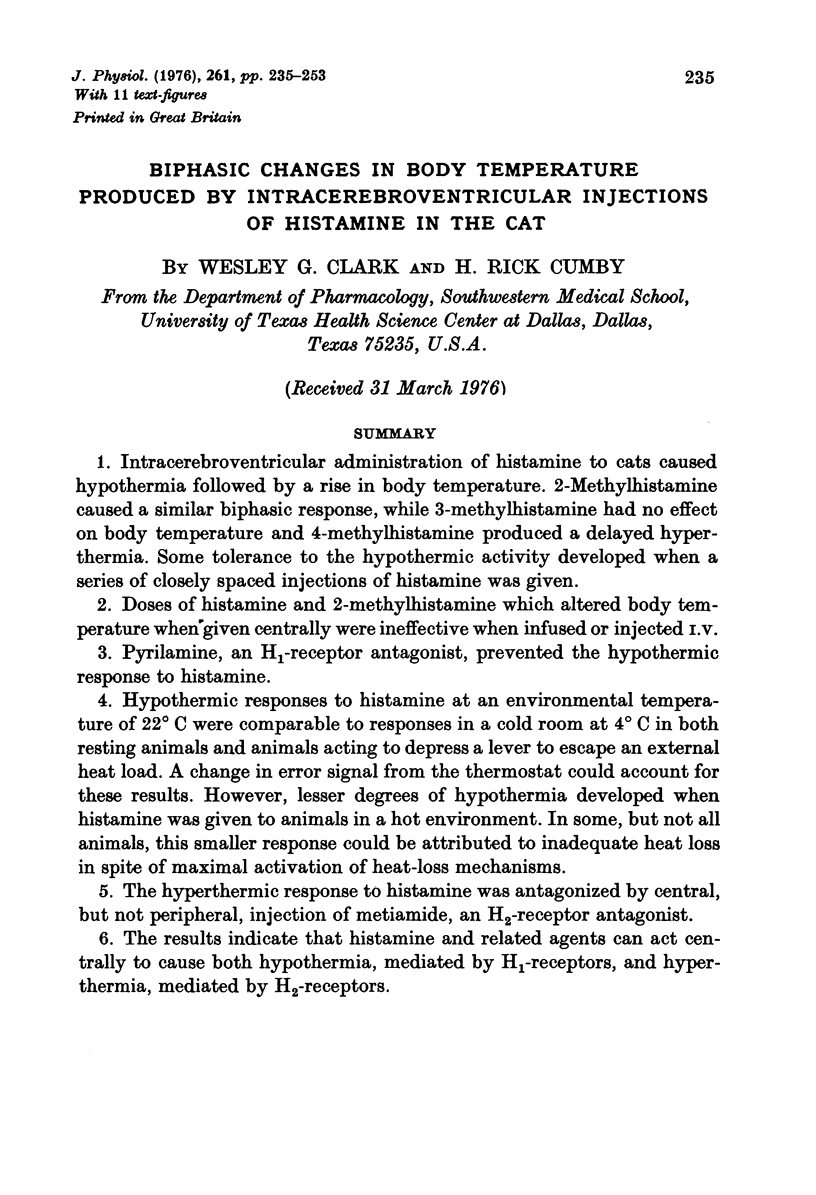
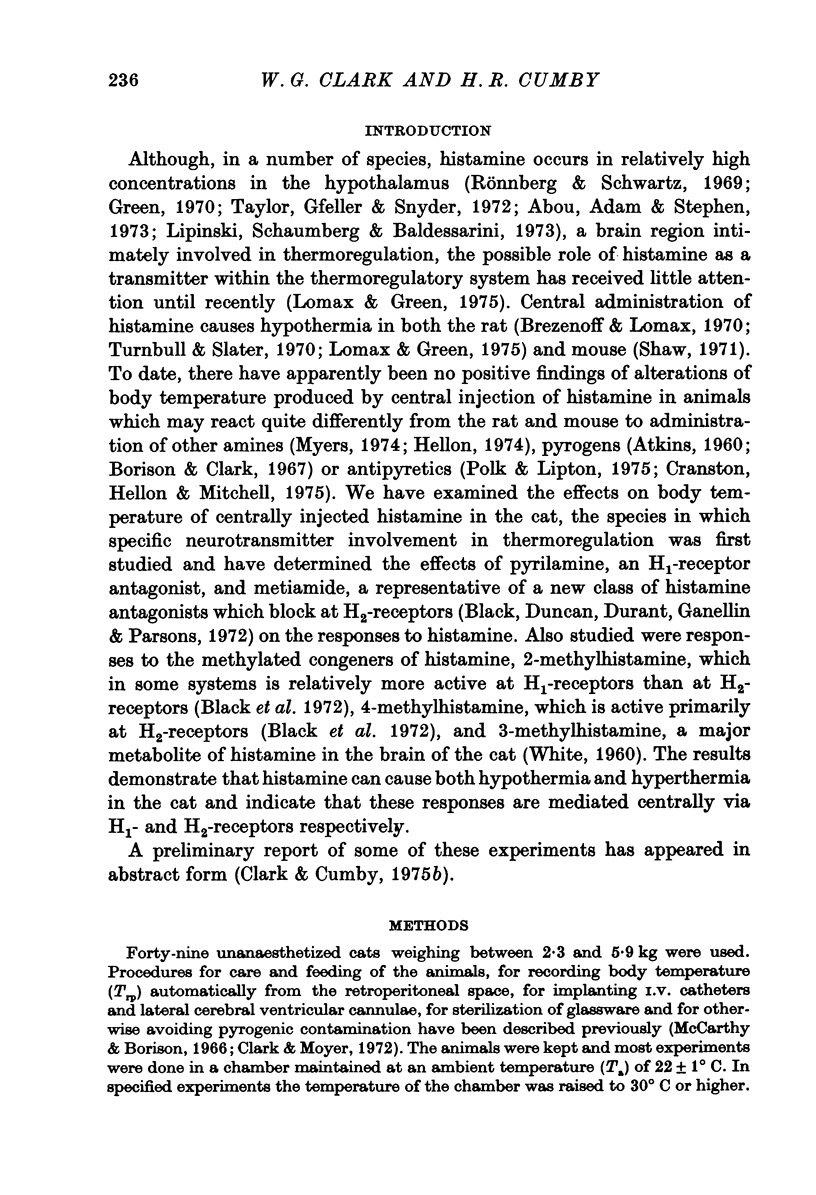
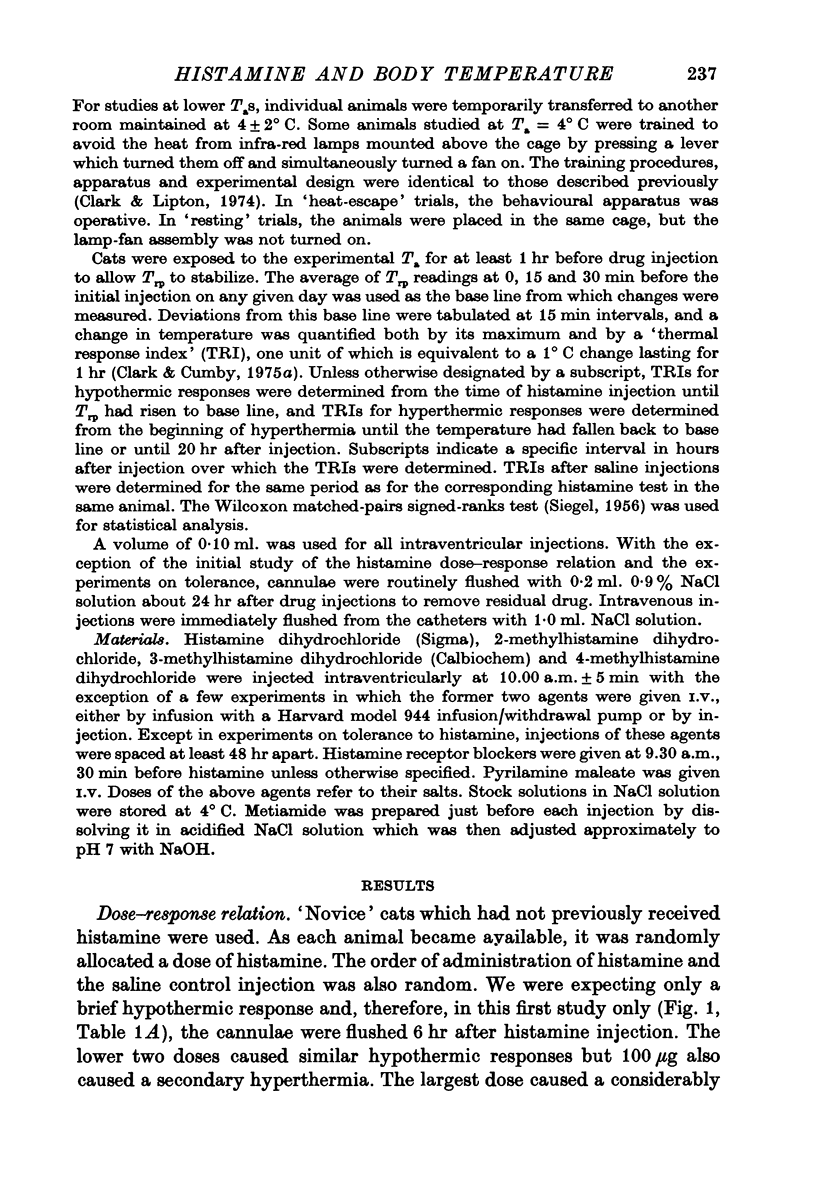
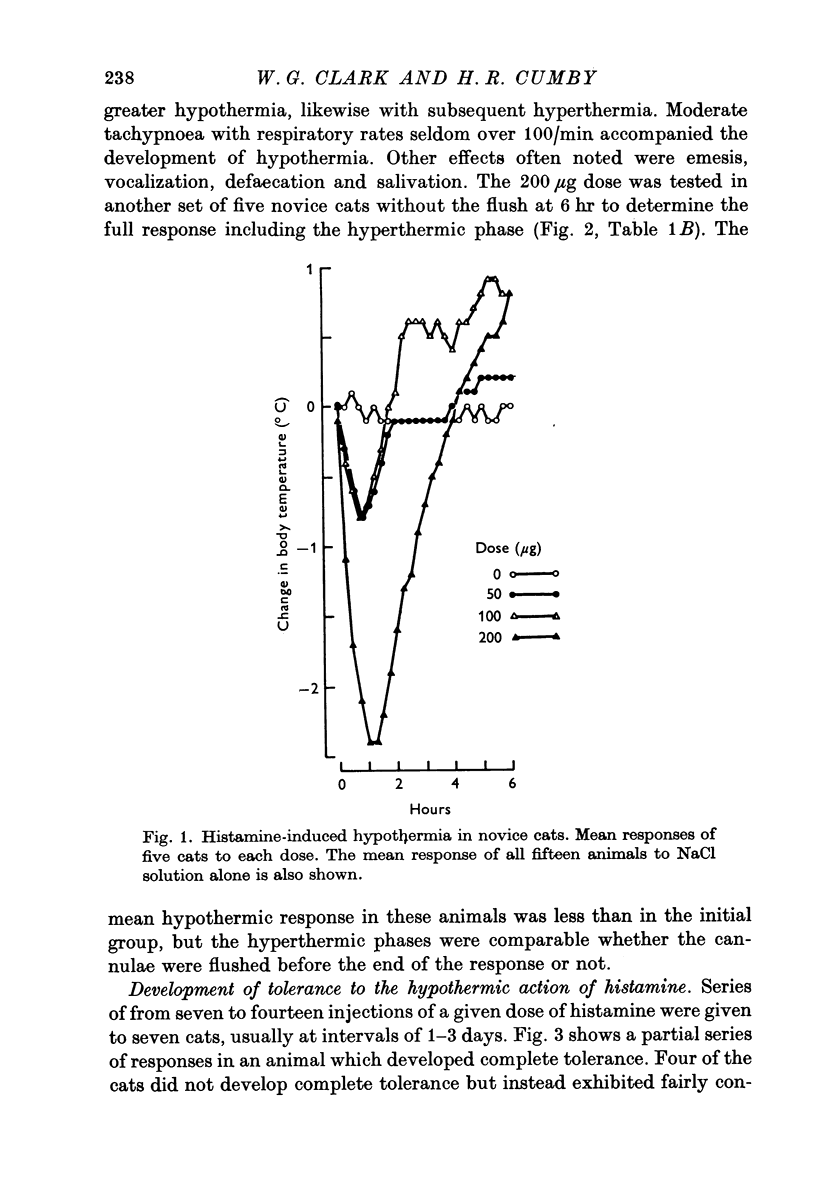
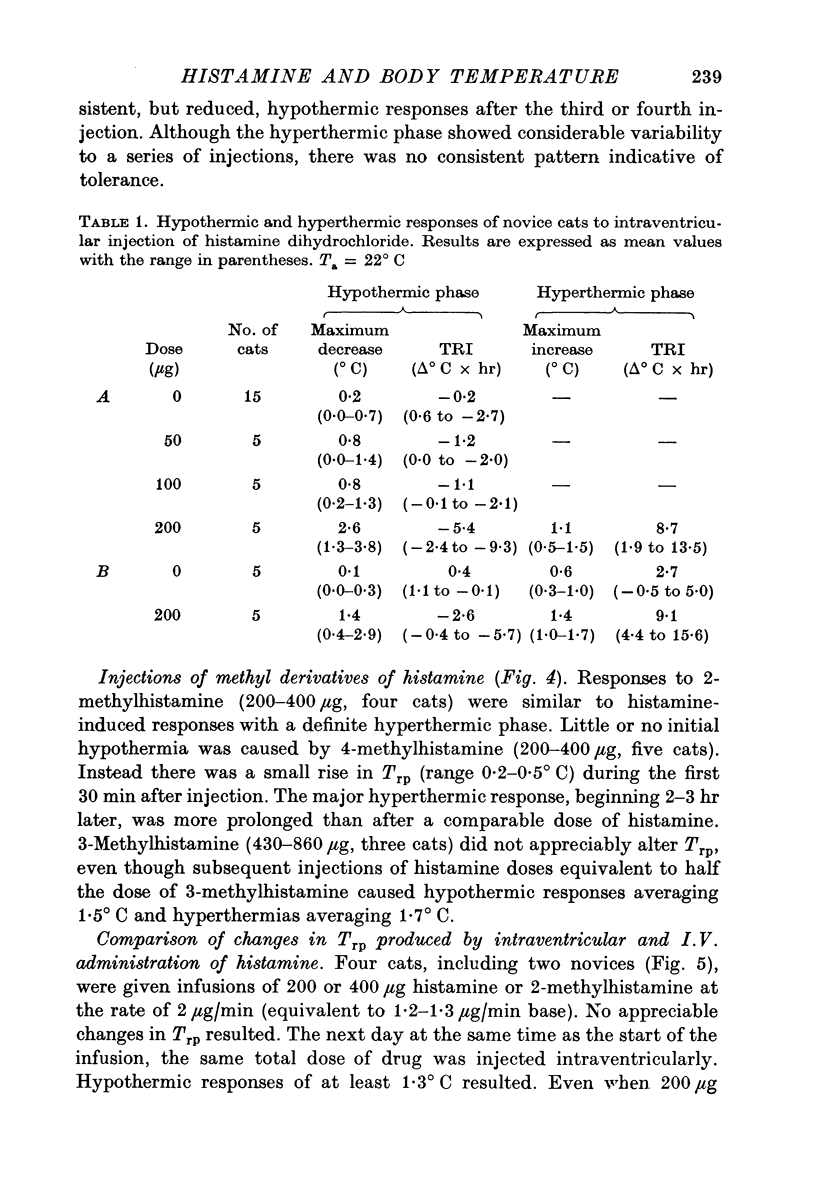
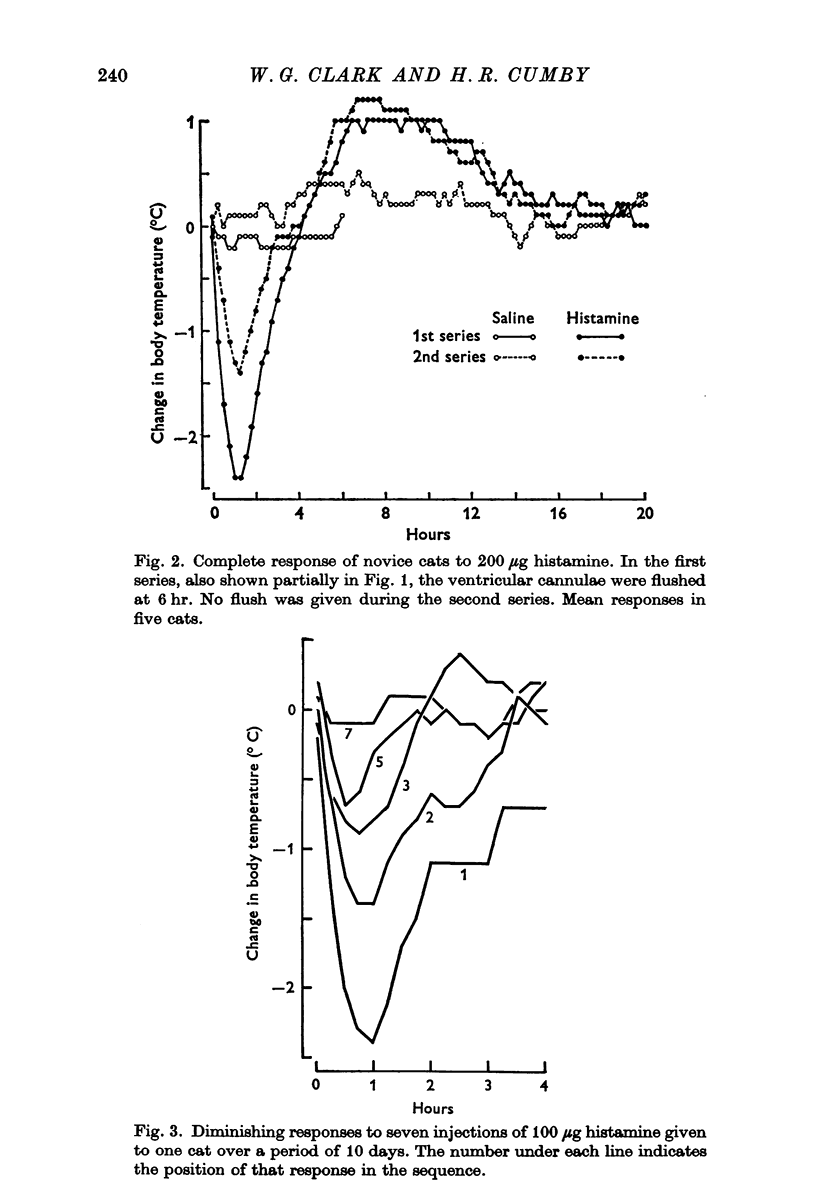
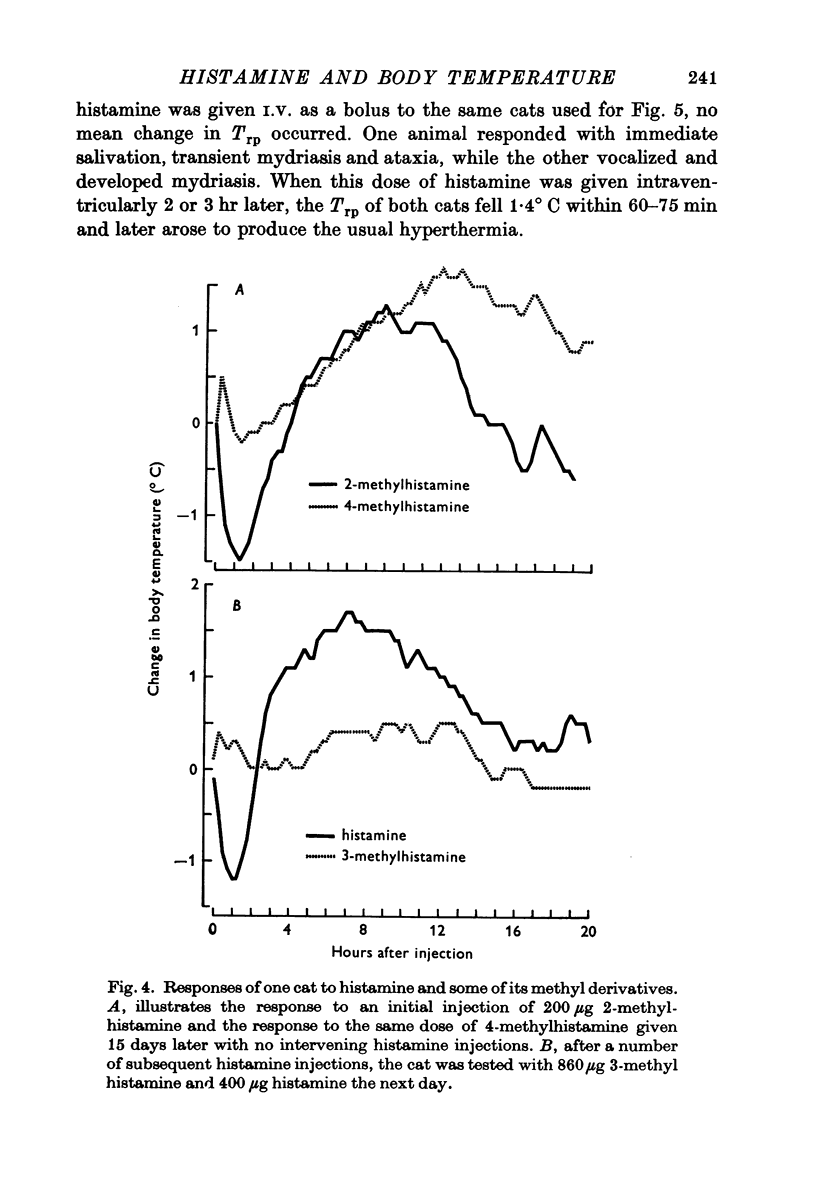

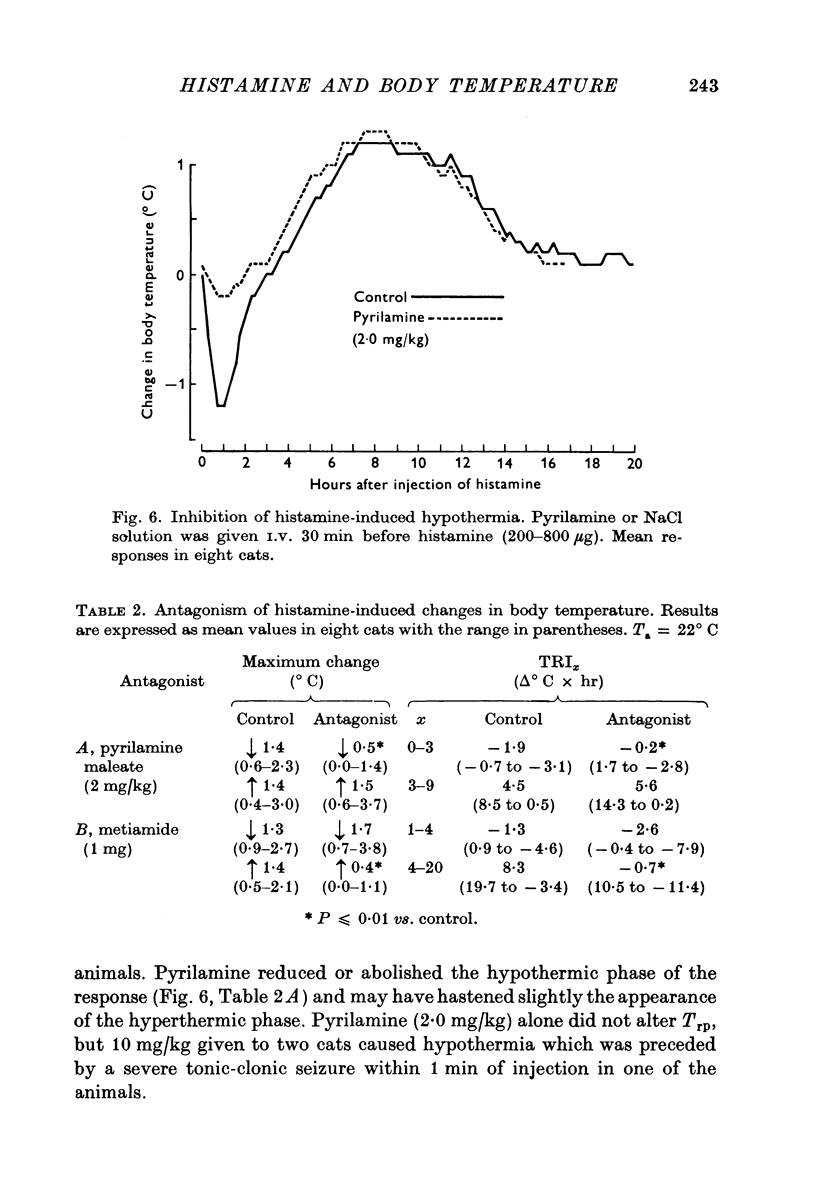
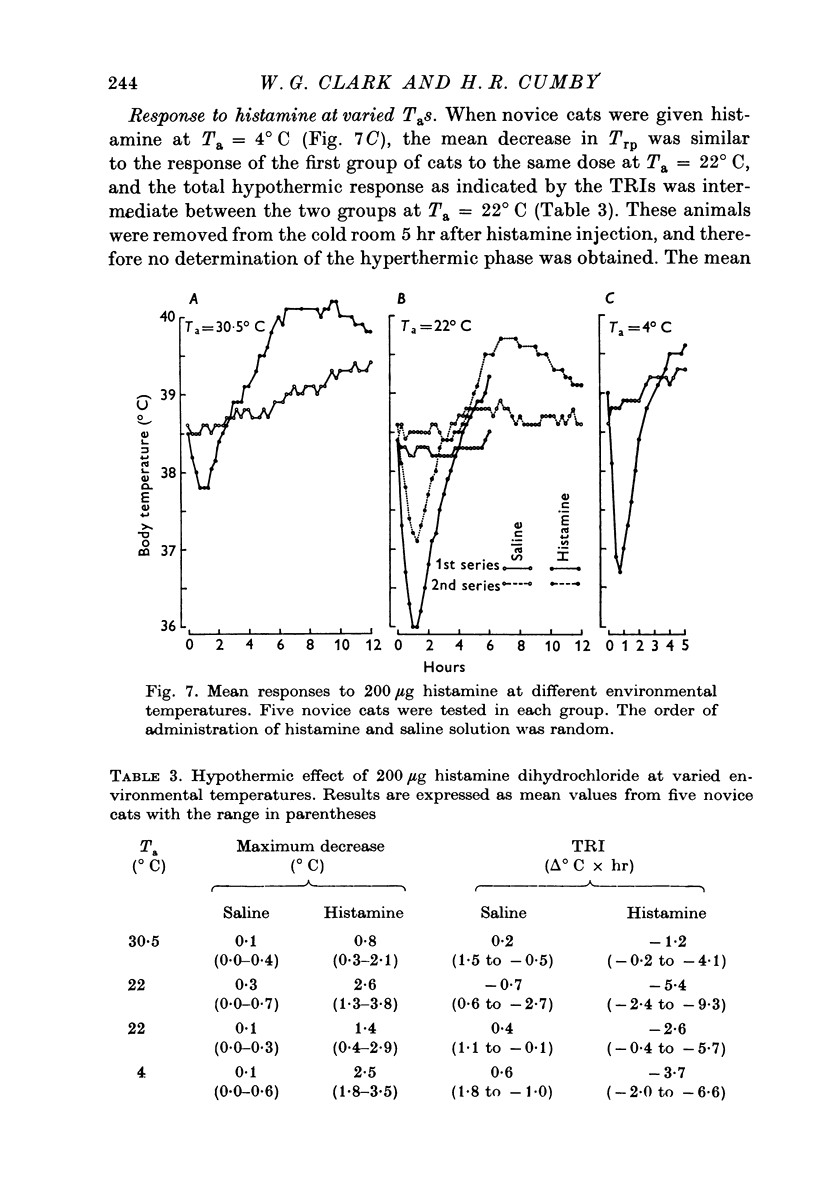
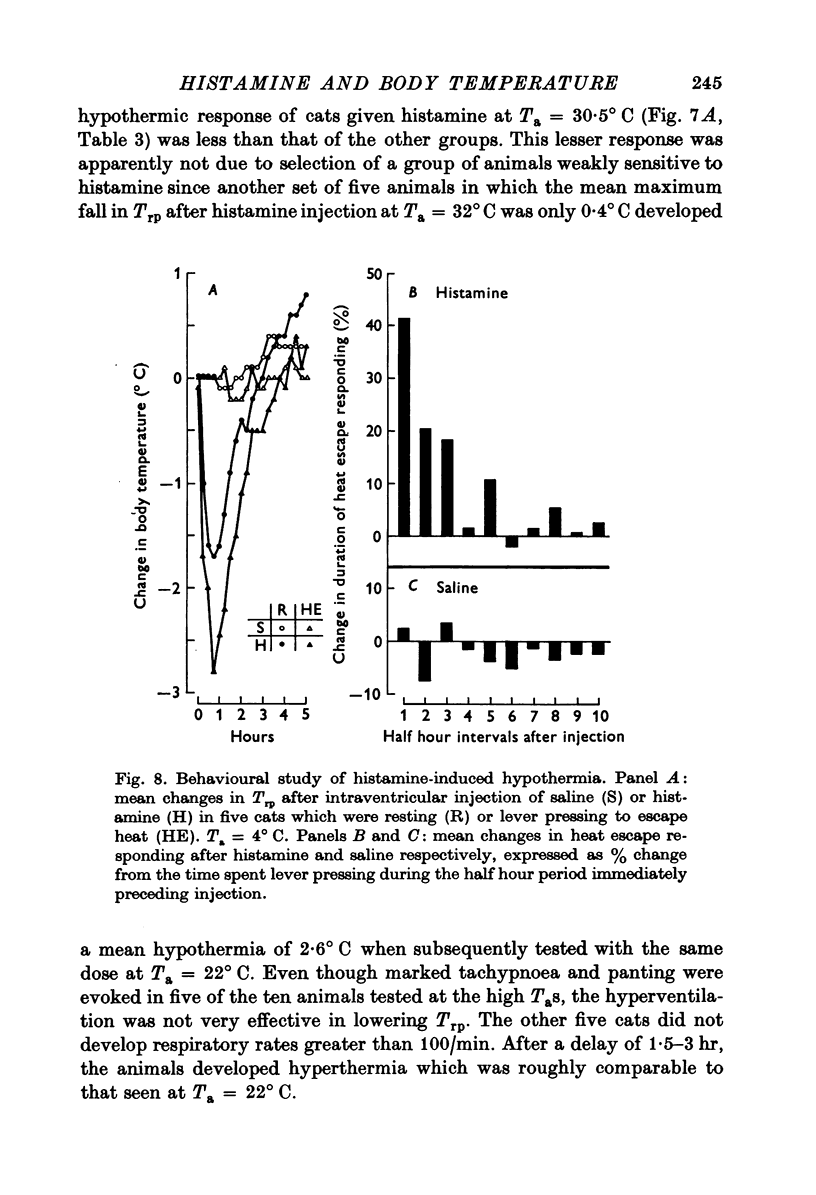
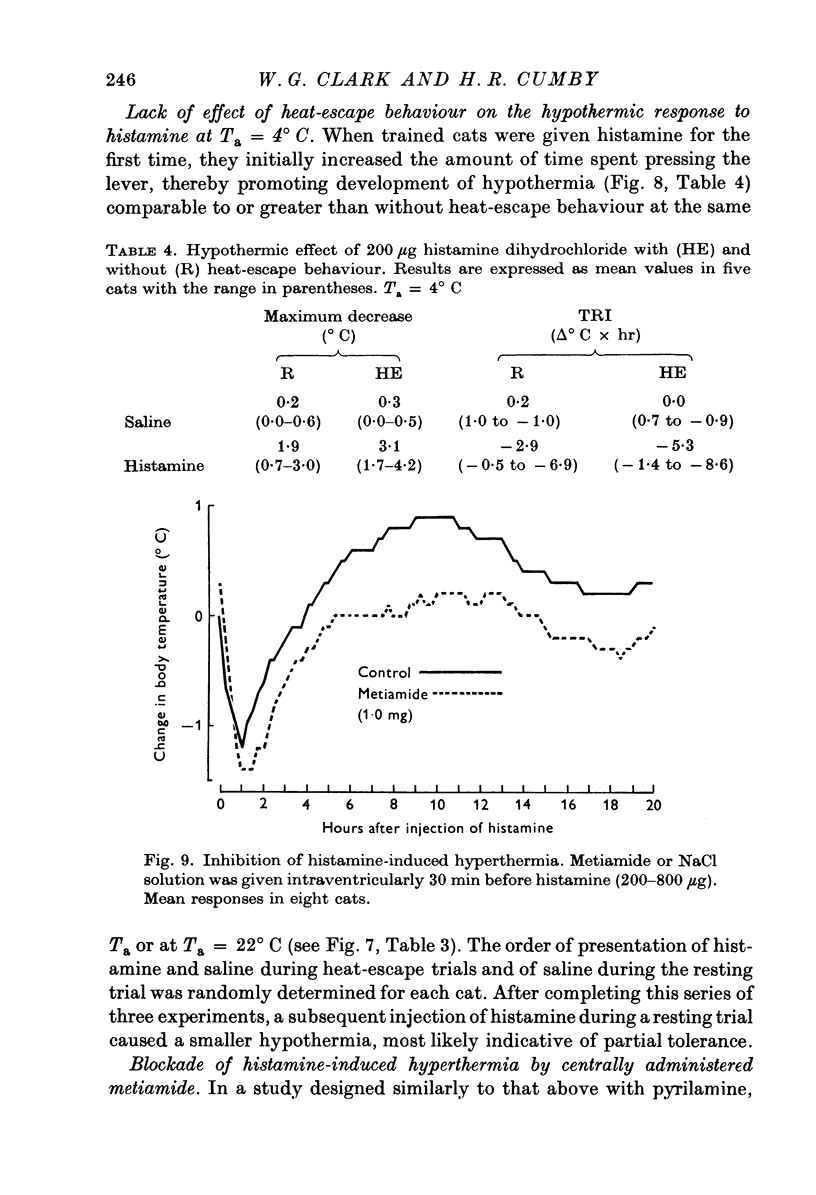
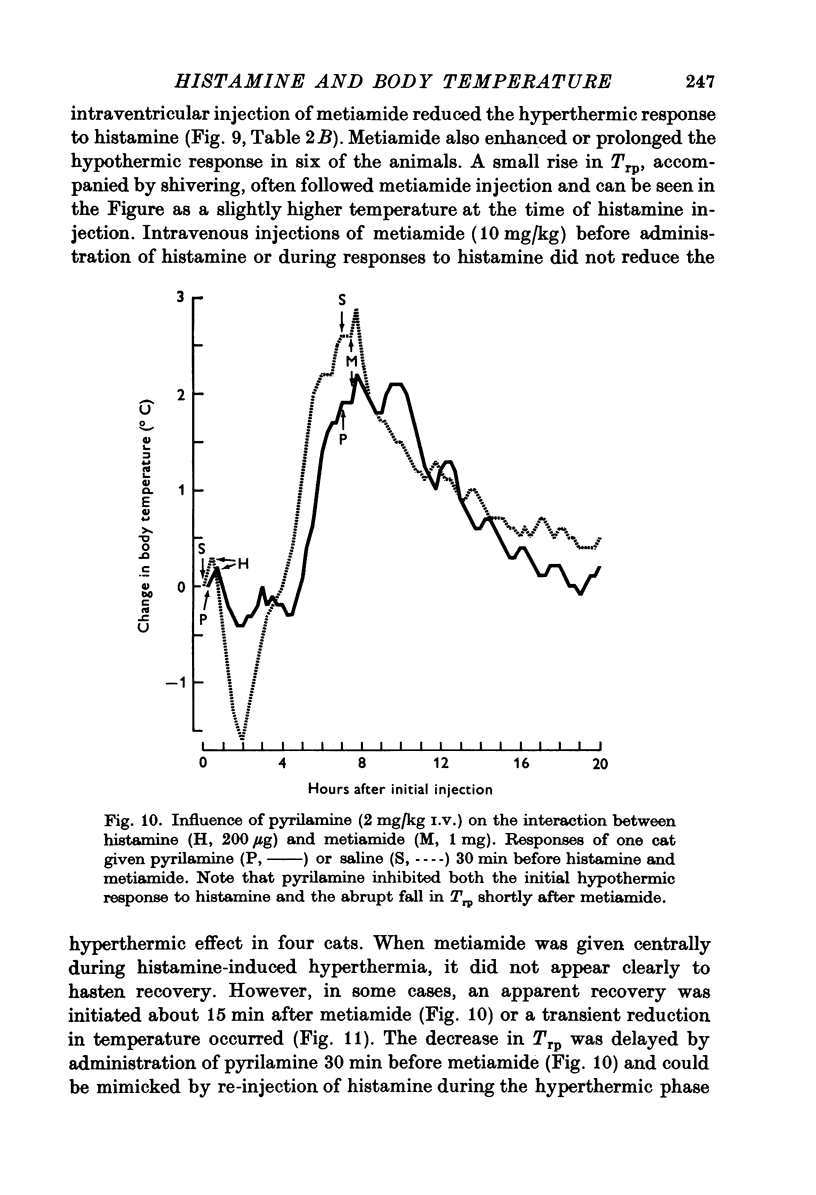
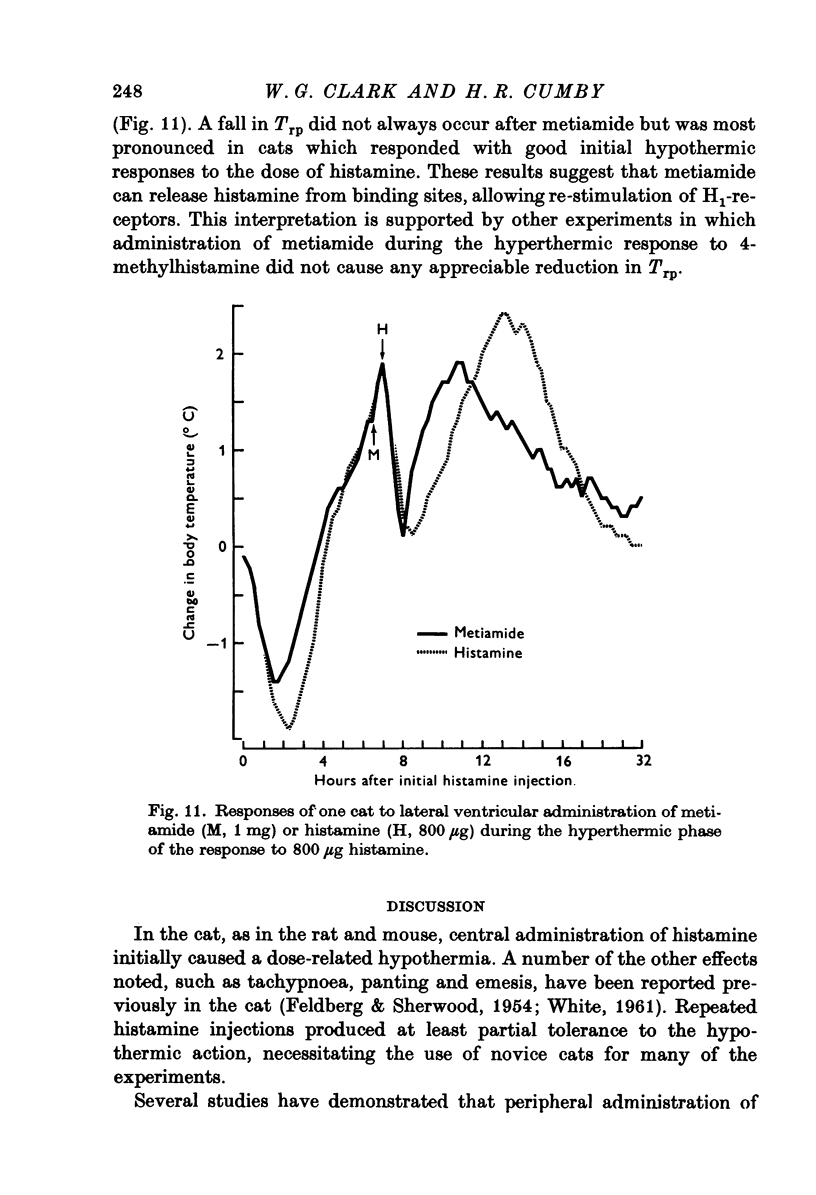
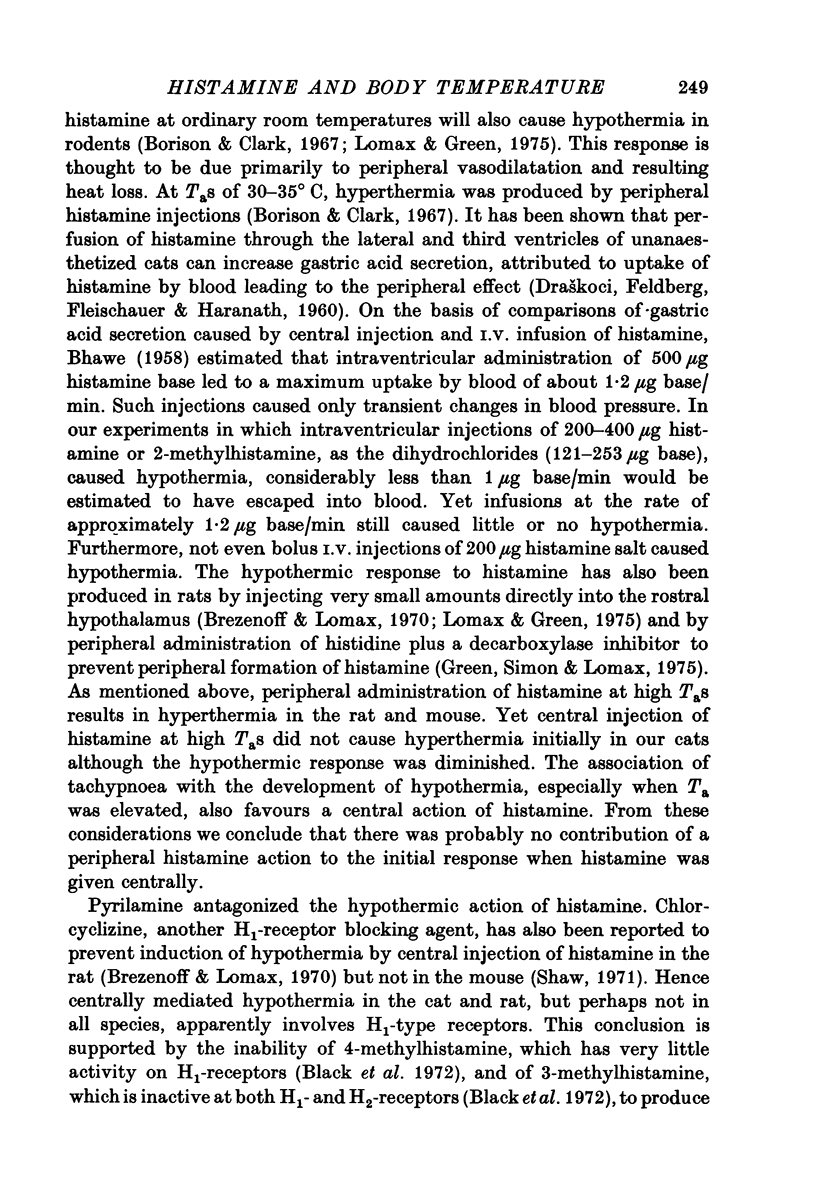
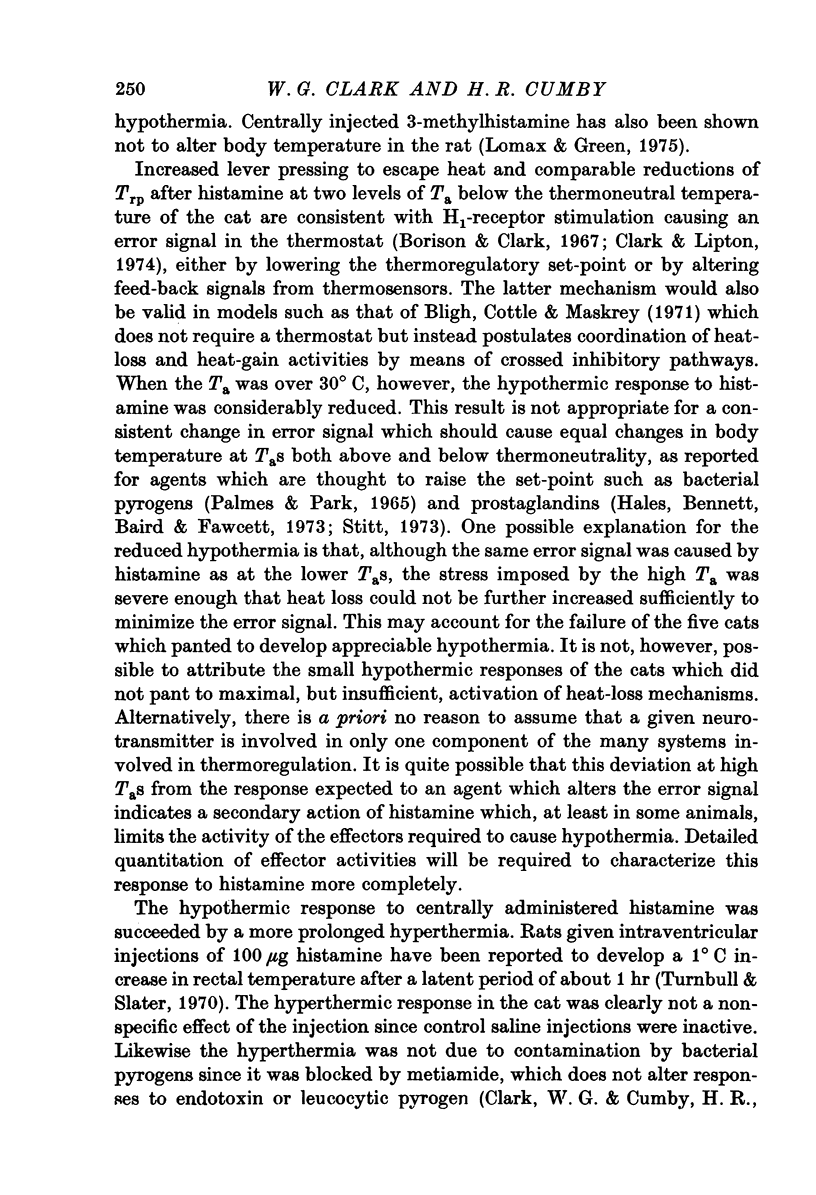
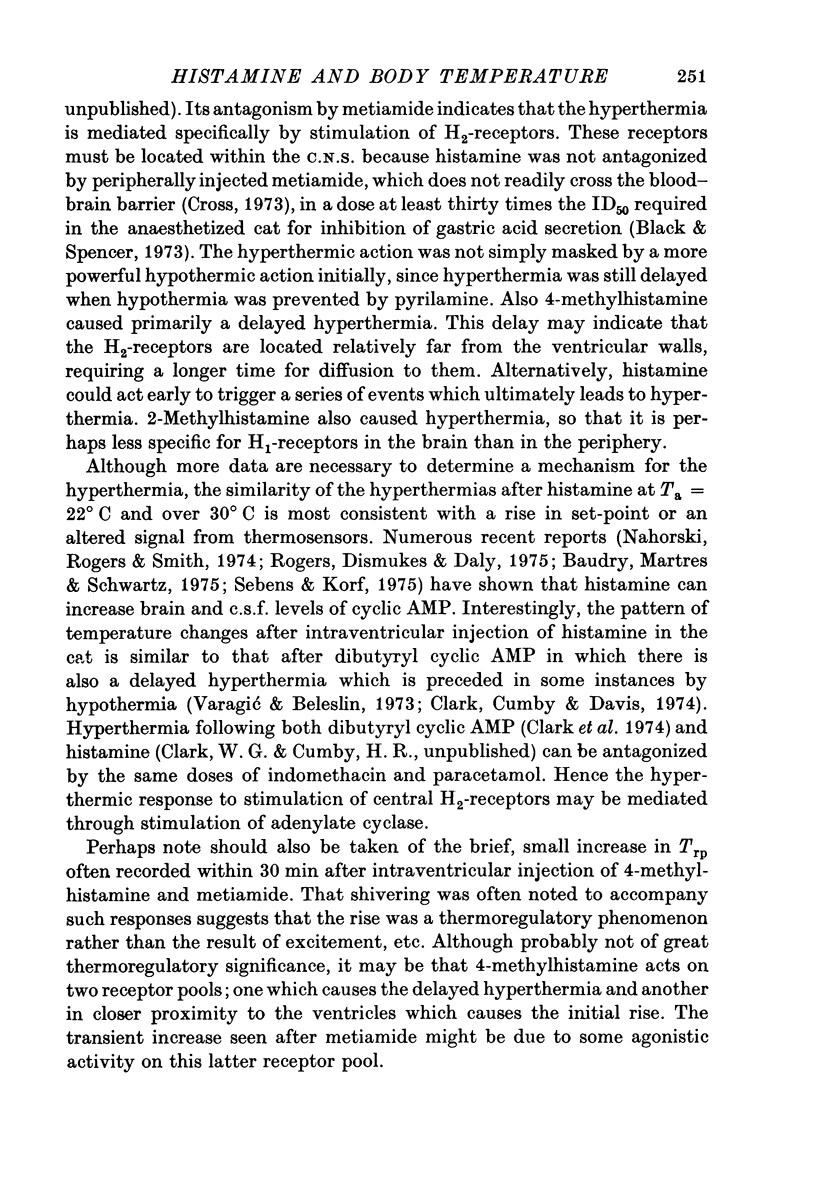
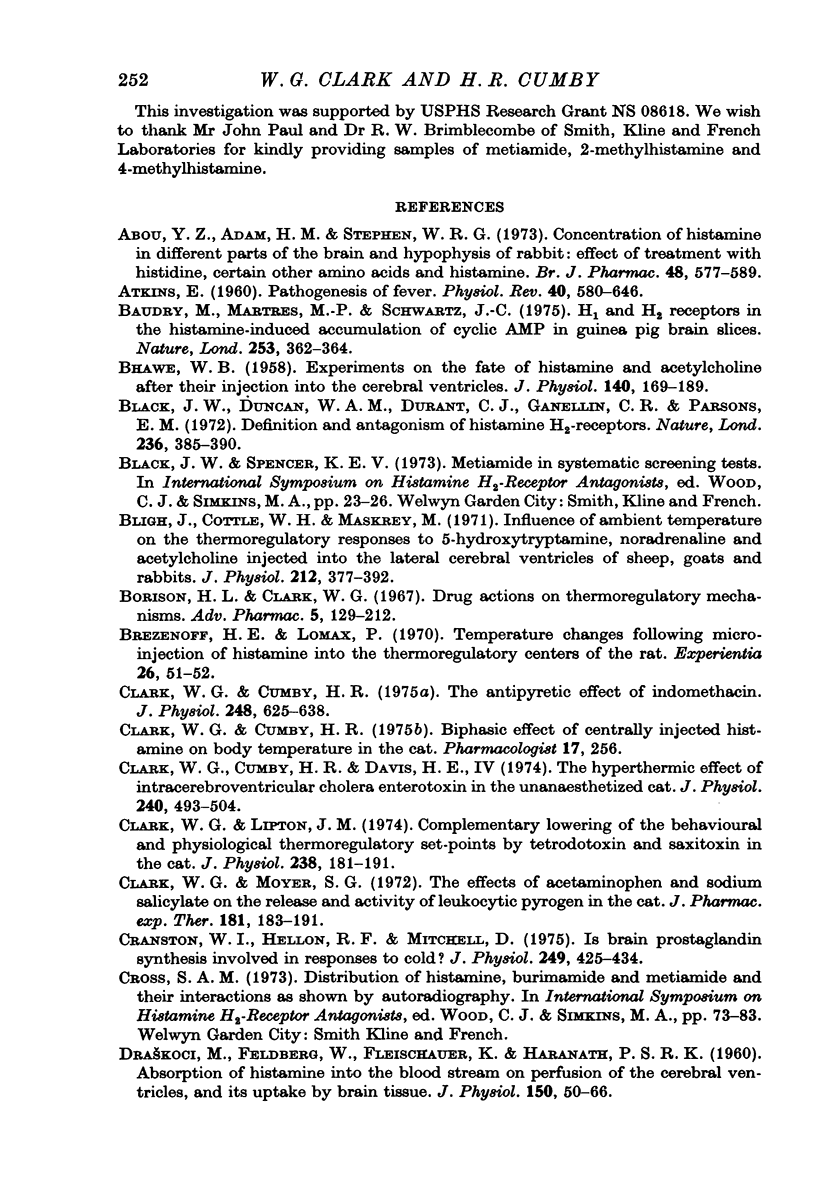
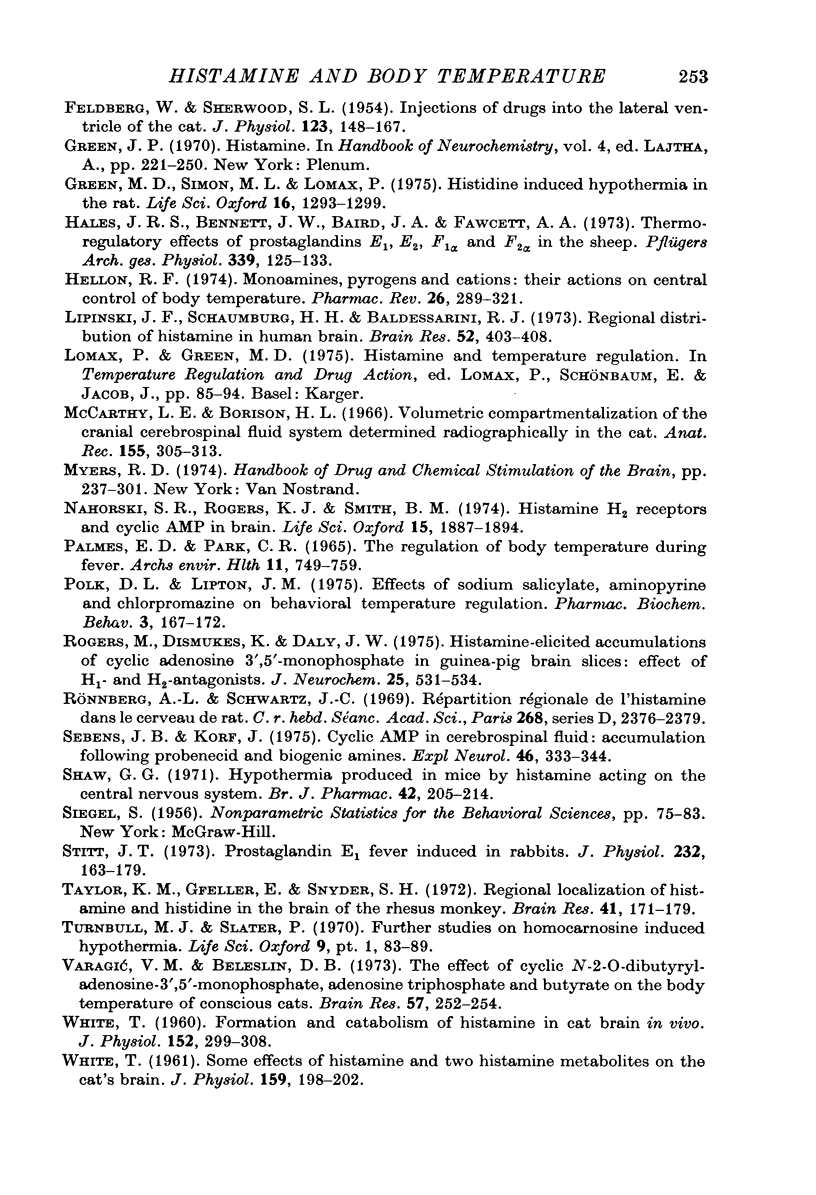
Selected References
These references are in PubMed. This may not be the complete list of references from this article.
- ATKINS E. Pathogenesis of fever. Physiol Rev. 1960 Jul;40:580–646. doi: 10.1152/physrev.1960.40.3.580. [DOI] [PubMed] [Google Scholar]
- Abou Y. Z., Adam H. M., Stephen W. R. Concentration of histamine in different parts of the brain and hypophysis of rabbit: effect of treatment with histidine, certain other amino acids and histamine. Br J Pharmacol. 1973 Aug;48(4):577–589. doi: 10.1111/j.1476-5381.1973.tb08244.x. [DOI] [PMC free article] [PubMed] [Google Scholar]
- BHAWE W. B. Experiments on the fate of histamine and acetylcholine after their injection into the cerebral ventricles. J Physiol. 1958 Feb 17;140(2):169–189. doi: 10.1113/jphysiol.1958.sp005925. [DOI] [PMC free article] [PubMed] [Google Scholar]
- Baudry M., Martres M. P., Schwartz J. C. H1 and H2 receptors in the histamine-induced accumulation of cyclic AMP in guinea pig brain slices. Nature. 1975 Jan 31;253(5490):362–364. doi: 10.1038/253362a0. [DOI] [PubMed] [Google Scholar]
- Black J. W., Duncan W. A., Durant C. J., Ganellin C. R., Parsons E. M. Definition and antagonism of histamine H 2 -receptors. Nature. 1972 Apr 21;236(5347):385–390. doi: 10.1038/236385a0. [DOI] [PubMed] [Google Scholar]
- Bligh J., Cottle W. H., Maskrey M. Influence of ambient temperature on the thermoregulatory responses to 5-hydroxytryptamine, noradrenaline and acetylcholine injected into the lateral cerebral ventricles of sheep, goats and rabbits. J Physiol. 1971 Jan;212(2):377–392. doi: 10.1113/jphysiol.1971.sp009330. [DOI] [PMC free article] [PubMed] [Google Scholar]
- Borison H. L., Clark W. G. Drug actions on thermoregulatory mechanisms. Adv Pharmacol. 1967;5:129–212. doi: 10.1016/s1054-3589(08)60657-2. [DOI] [PubMed] [Google Scholar]
- Brezenoff H. E., Lomax P. Temperature changes following microinjection of histamine into the thermoregulatory centers of the rat. Experientia. 1970 Jan 15;26(1):51–52. doi: 10.1007/BF01900386. [DOI] [PubMed] [Google Scholar]
- Clark W. G., Cumby H. R., Davis N. E., 4th The hyperthermic effect of intracerebroventricular cholera enterotoxin in the unanaesthetized cat. J Physiol. 1974 Jul;240(2):493–504. doi: 10.1113/jphysiol.1974.sp010619. [DOI] [PMC free article] [PubMed] [Google Scholar]
- Clark W. G., Cumby H. R. The antipyretic effect of indomethacin. J Physiol. 1975 Jul;248(3):625–638. doi: 10.1113/jphysiol.1975.sp010992. [DOI] [PMC free article] [PubMed] [Google Scholar]
- Clark W. G., Lipton J. M. Complementary lowering of the behavioural and physiological thermoregulatory set-points by tetrodotoxin and saxitoxin in the cat. J Physiol. 1974 Apr;238(1):181–191. doi: 10.1113/jphysiol.1974.sp010517. [DOI] [PMC free article] [PubMed] [Google Scholar]
- Clark W. G., Moyer S. G. The effects of acetaminophen and sodium salicylate on the release and activity of leukocytic pyrogen in the cat. J Pharmacol Exp Ther. 1972 Apr;181(1):183–191. [PubMed] [Google Scholar]
- Cranston W. I., Hellon R. F., Mitchell D. Is brain prostaglandin synthesis involved in responses to cold? J Physiol. 1975 Jul;249(2):425–434. doi: 10.1113/jphysiol.1975.sp011023. [DOI] [PMC free article] [PubMed] [Google Scholar]
- DRASKOCI M., FELDBERG W., FLEISCHHAUER K., HARANATH P. S. Absorption of histamine into the blood stream on perfusion of the cerebral ventricles, and its uptake by brain tissue. J Physiol. 1960 Jan;150:50–66. doi: 10.1113/jphysiol.1960.sp006372. [DOI] [PMC free article] [PubMed] [Google Scholar]
- FELDBERG W., SHERWOOD S. L. Injections of drugs into the lateral ventricle of the cat. J Physiol. 1954 Jan;123(1):148–167. doi: 10.1113/jphysiol.1954.sp005040. [DOI] [PMC free article] [PubMed] [Google Scholar]
- Green M. D., Simon M. L., Lomax P. Histidine induced hypothermia in the rat. Life Sci. 1975 Apr 15;16(8):1293–1299. doi: 10.1016/0024-3205(75)90314-8. [DOI] [PubMed] [Google Scholar]
- Hales J. R., Bennett J. W., Baird J. A., Fawcett A. A. Thermoregulatory effects of prostaglandins E 1 , E 2 , F 1 and F 2 in the sheep. Pflugers Arch. 1973 Mar 21;339(2):125–133. doi: 10.1007/BF00587179. [DOI] [PubMed] [Google Scholar]
- Hellon R. F. Monoamines, pyrogens and cations: their actions on central control of bodytemperature. Pharmacol Rev. 1974 Dec;26(4):289–321. [PubMed] [Google Scholar]
- Lipinski J. F., Schaumberg H. H., Baldessarini R. J. Regional distribution of histamine in human brain. Brain Res. 1973 Mar 30;52:403–408. doi: 10.1016/0006-8993(73)90681-1. [DOI] [PubMed] [Google Scholar]
- McCarthy L. E., Borison H. L. Volumetric compartmentalization of the cranial cerebrospinal fluid system determined radiographically in the cat. Anat Rec. 1966 Jul;155(3):305–313. doi: 10.1002/ar.1091550304. [DOI] [PubMed] [Google Scholar]
- Palmes E. D., Park C. R. The regulation of body temperature during fever. Arch Environ Health. 1965 Dec;11(6):749–759. doi: 10.1080/00039896.1965.10664295. [DOI] [PubMed] [Google Scholar]
- Polk D. L., Lipton J. M. Effects of sodium salicylate, aminopyrine and chlorpromazine on behavioral temperature regulation. Pharmacol Biochem Behav. 1975 Mar-Apr;3(2):167–172. doi: 10.1016/0091-3057(75)90143-4. [DOI] [PubMed] [Google Scholar]
- Rogers M., Dismukes K., Daly J. W. Histamine-elicited accumulations of cyclic adenosine 3',5'-monophosphate in guinea-pig brain slices: effect of H1- and H2-antagonists. J Neurochem. 1975 Oct;25(4):531–534. doi: 10.1111/j.1471-4159.1975.tb04361.x. [DOI] [PubMed] [Google Scholar]
- Rönnberg A. L., Schwartz J. C. Répartition régionale de l'histamine dans le cerveau de rat. C R Acad Sci Hebd Seances Acad Sci D. 1969 May 12;268(19):2376–2379. [PubMed] [Google Scholar]
- Sebens J. B., Korf J. Cyclic AMP in cerebrospinal fluid: accumulaiton following probenecid and biogenic amines. Exp Neurol. 1975 Feb;46(2):333–344. doi: 10.1016/0014-4886(75)90139-9. [DOI] [PubMed] [Google Scholar]
- Shaw G. G. Hypothermia produced in mice by histamine acting on the central nervous system. Br J Pharmacol. 1971 Jun;42(2):205–214. doi: 10.1111/j.1476-5381.1971.tb07101.x. [DOI] [PMC free article] [PubMed] [Google Scholar]
- Stitt J. T. Prosaglandin E1 fever induced in rabbits. J Physiol. 1973 Jul;232(1):163–179. doi: 10.1113/jphysiol.1973.sp010262. [DOI] [PMC free article] [PubMed] [Google Scholar]
- Taylor K. M., Gfeller E., Snyder S. H. Regional localization of histamine and histidine in the brain of the rhesus monkey. Brain Res. 1972 Jun 8;41(1):171–179. doi: 10.1016/0006-8993(72)90624-5. [DOI] [PubMed] [Google Scholar]
- Varagić V. M., Beleslin D. B. The effect of cyclic N-2-O-dibutyryl-adenosine-3',5'-monophosphate, adenosine triphosphate and butyrate on the body temperature of conscious cats. Brain Res. 1973 Jul 16;57(1):252–254. doi: 10.1016/0006-8993(73)90587-8. [DOI] [PubMed] [Google Scholar]
- WHITE T. Formation and catabolism of histamine in cat brain in vivo. J Physiol. 1960 Jul;152:299–308. doi: 10.1113/jphysiol.1960.sp006488. [DOI] [PMC free article] [PubMed] [Google Scholar]
- WHITE T. Some effects of histamine and two histamine metabolites on the cat's brain. J Physiol. 1961 Dec;159:198–202. doi: 10.1113/jphysiol.1961.sp006802. [DOI] [PMC free article] [PubMed] [Google Scholar]


